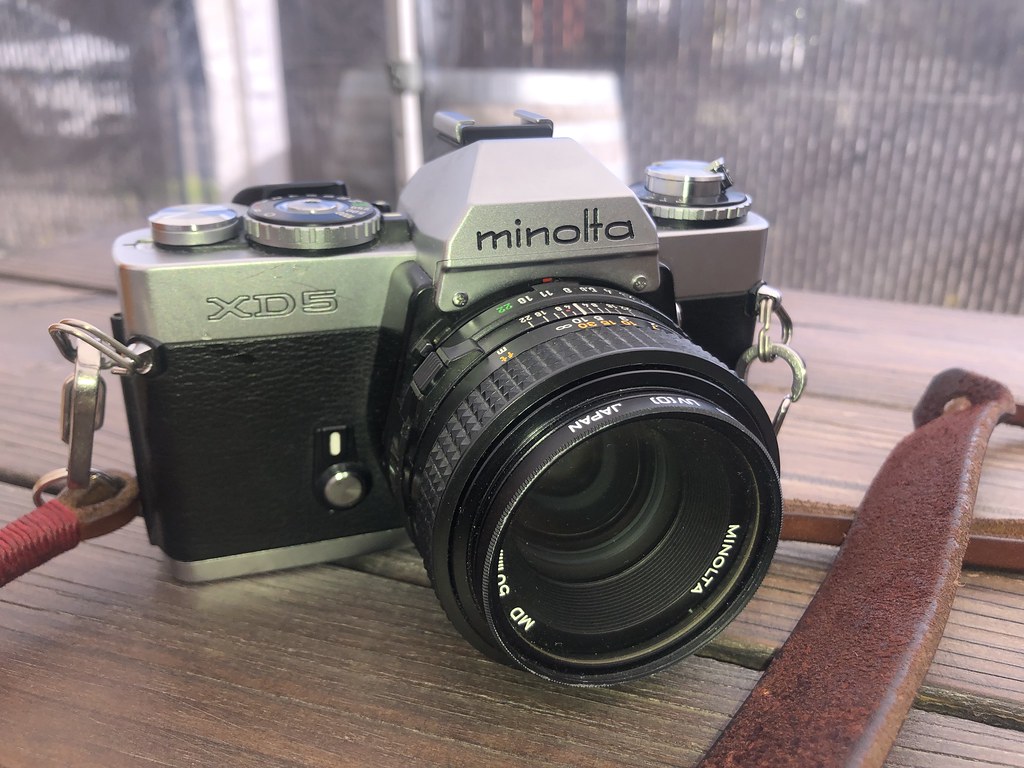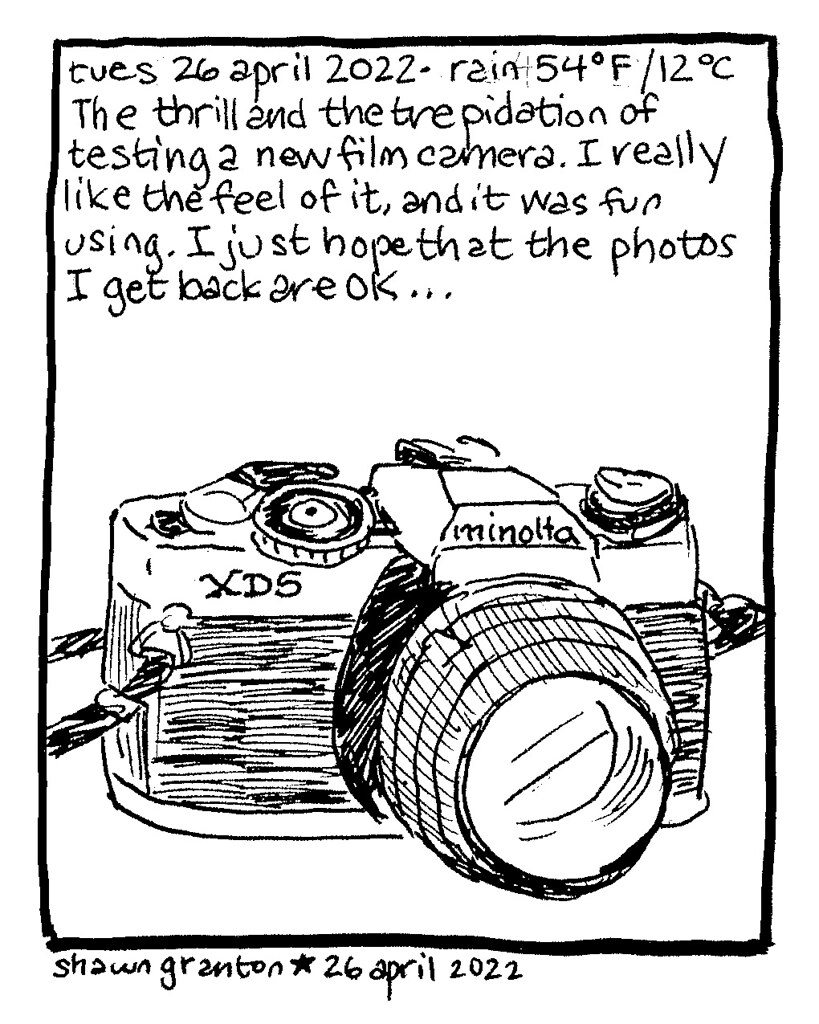
It’s been almost two and a half years since I got back into film photography. I’ve tried a bunch of different 35mm cameras during that time, including rangefinders, zone-focus viewfinders, superzooms, and half-frame. But I’ve only used one SLR (single-lens reflex), the Minolta SR-T 101 I got in October of 2020. I really like this camera and like the idea of SLRs. But I didn’t embrace this camera type as much as the others.
For some, an SLR is the ideal: you “see” through the lens, so you know exactly how your composition is going to turn out (vs. the “mostly true” that you get through a separate viewfinder.) And pretty much every SLR ever made allows you the ability to change lenses to get different focal lengths. (You can do that with an interchangeable-lens rangefinder, but you are limited to a few different focal lengths, and these types of cameras and their attendant lenses are pretty expensive.) I get these two benefits, but the style of shooting I do, usually aided by a bicycle, works best with smaller cameras.
And my Minolta SR-T 101 is by no means small. It comes from an era (mid-60’s) where pro-level SLRs were expected to be bulky and weighty. In fact, the descriptor most often used for the SR-T series is “heavy”. 1 And while it has a perfectly fine metering system, there’s no autoexposure capabilities. I figured that at some point I might want to give another SLR a shot, one that is both smaller and has some autoexposure capability.
But the hunt for another SLR was a back-burner project, especially since I had many other cameras in my arsenal and I didn’t really know what one to get. Then this year I started to use the SR-T 101 more than I had in the past. I got more used to shooting with an SLR, and liked it more and more. Then I noticed that the SR-T 101 was having a slight issue, meaning it’ll need to get serviced soon. This could mean two to three months without it. Before that didn’t seem that big of a deal, but now it was. I’d need another SLR in the stable when that happens.
But what one? That was the quandary that made me put off the search for a long time. There was a smallish window for the era of compact, manual-focus auto-exposure SLR, from the mid-70s into the mid-80s, when the cameras got bulky again to accommodate auto-winding and auto-focus. The Olympus OM series was the progenitor of this type of SLR. I really like Olympus and love the look. I just don’t like the prices these cameras now fetch. And a new-to-me camera system would mean acquiring new-to-me lenses, costing even more money. The choice was clear: I’d go with Minolta. I already have lenses for the SR-T 101, so I could use them on the new camera.
Initially I had been looking at either something like the X-700 or X-570, Minoltas final manual-focus cameras using the SR mount. I also was looking at the XG-M, the best of the amateur-friendly XG line. All of them were smallish and relatively lightweight, and each have some form of auto-exposure, whether it be aperture priority or program (full autoexposure.) But while these cameras (esp. the X-700) have good reputations, they are mostly plastic.

Then the XD series came up on my radar. The XD series was introduced in 1977 with the XD (known as the XD11 in the US and XD7 in Europe.) This camera was the first to feature both shutter priority and aperture priority modes. And it’s more compact size was definitely a response to the Olympus OM1. It’s also the second SLR that Minolta designed in collaboration with Leica, the Leica version being their R4. Why didn’t I think about this camera before? Probably because there’s so many Minolta SLRs that start with “X” that I got confused. (And I like Minolta!)
The XD was a very sophisticated camera for its day, and well respected. And while they didn’t seem super-expensive, the prices I saw on eBay for anything that wasn’t “untested” or “parts only” was more than I cared to spend. Thankfully Minolta realized that they needed a slightly more downmarket version of this camera, so they released the XD5 in 1979. It lacks a few of the extras of the XD/7/11, like viewfinder blind, “safe-load” film indicator, and aperture readout in the viewfinder. But my SR-T 101 had none of those things, so I figured I could live without those extras to get a camera at a lower cost. The Rokkor Files states that “the mechanical and electronic components of the cameras are identical” 2 so I wouldn’t be losing out on quality.
So bid on one that looked good and won. But it was a lemon: despite fresh batteries (and the LEDs in the viewfinder lighting up), the shutter only fired at the mechanical speed of 1/100 second. The XD series are fully electronic cameras (pretty much any Minolta SLR after the SRT series is), and without functioning electronics, it’s basically a paperweight. So much for “it worked the last time I used it”. 3
But even broken, I knew that I wanted another one. The XD5 just felt right. It’s definitely more compact than the SR-T 101: with the standard Minolta MD 50mm f/1.7 lens, it weighs about 1 lb, 10 oz–an ounce less than my Minolta Hi-Matic 7s, which is a rangefinder! And the leather covering was actual nice leather vs. the pebbled “leatherette” on my other cameras–it felt nice in the hand.
So I got another one. This one cost me $80, which is more than I usually spend on a camera. But it was sold as film tested, so it was worth a shot. And yes, the thing worked! A test with fresh batteries confirmed that the shutter speeds were firing correctly, at least as far as I can tell. I loaded up a roll of Kodak Ultramax 400 and shot a test roll.
Shooting was fun. While the XD5 features full manual exposure control (with full metering, which wasn’t that common in some of these electronic SLRs), I shot most of the roll in Aperture Priority. Even though I haven’t owned any cameras with this feature, I already knew that I would take to it. And I did. With the camera in this mode, the viewfinder would light up (via LED) what shutter speed it chooses. Often it would show a readout of something like 1/125 and 1/60–since the shutter is electronically controlled, it will pick a speed somewhere in between for best exposure.
But there’s a third mode, and it’s Shutter Priority. The XD series was the first to offer both Aperture and Shutter Priority modes. The addition of Shutter Priority necessitated Minolta to tweak their almost two decade old SR lens mount. This “tweak” is known as MD for Maximum Diaphragm. These lenses have an extra tab on that interfaces with the body, telling the camera what the smallest aperture on the lens is. This is one of the reasons why I wanted an XD5 with an MD 50mm f/1.7 lens–while my MC 50mm f/1.4 on my SR-T 101 is technically a “better” and faster lens, without that extra tab I couldn’t use it in Shutter Priority mode, just manual and Aperture Priority.4
I don’t think I’ll use Shutter Priority that much, but it is nice to have available. Amazingly, as far as I know the XD series is the only Minolta manual-focus SLR to offer Shutter Priority–the XG and X series that followed only had Aperture Priority and in the case of the X-700, full Program mode. Interestingly enough, though, the Shutter Priority mode on the XD series is “sort of” a Program mode: Via The Rokkor Files, “if the selected speed is insufficient at the widest aperture, it will reduce the speed until a correct exposure ensues.” Neat! This is done via a Final Check in the auto modes, which causes a slight, yet noticeable delay in the shutter release.
I got the scans from the test roll back and everything worked fine. While I like my MC 50mm f/1.4 lens better, the MD 50mm f/1.7 worked well. This camera is a keeper. At some point, I will get it CLA’d to hopefully keep it running for a long while.
And my Minolta XD5 is an SLR I can actually see traveling with. I only brought my SR-T 101 out-of-town when we were driving, where weight and space wasn’t much of an issue. But now that I have an SLR that’s about the same weight and even a bit smaller than my Minolta Hi-Matic 7s rangefinder (which I have traveled with), I can foresee taking it with me on plane and train adventures, maybe even possibly a bike tour. I won’t go hog-wild with lenses, probably just bring a prime with the MD 28-85mm zoom. That would be nice!

1 Yet as far as I can tell, the SR-T 101 was about the same weight as its counterparts, like the Nikon F. But people don’t usually mention the Nikon F’s weight as it’s primary quality. No, it’s usually something along the lines of “robust build”, “legendary”, “the choice of photojournalists in Vietnam”, or that it’s one of the best (or the best) cameras ever made. Minolta gets no respect.
2 Though according to a few “internet experts”, the XD5 has “more plastic” than the XD. But it’s in areas where it doesn’t matter much, like a metallized plastic top plate. It’s not like they replaced metal internals with plastic, which counts a lot more.
3 I really should follow the camera buying advice of Jerome from Earth, Sun, Film, who often asks sellers questions before he buys a camera. But most of the time I can’t be arsed.
4 The only other lens I own that can is my Minolta MD 28-85 zoom, which is a nice lens, but big and not a prime.

Glad to see you chose an XD5. Nice!
Reblogged this on Bikes and Film Cameras Club.
Hallo,
Excellent presentation, super superb!
Franjo R Glavina
Hello! nice review, I liked very much. I’m into analogue photography since 2020 and always with compact and fully automatic cameras. Now I have the opportunity yo buy a reflex one, and I am between the Minolta xd5 or a Pentax p30. Do you have any idea about the second one I mentioned? could you tell me which one would you choose? thank you! Lucia
Thank you for stopping by, Lucia!
I must admit, I’m always uneasy with these “Which one would you choose?” questions, especially when one of the choices is something I am not familiar with. I’ve only recently shot a Pentax SLR, and it’s not the P30. Taking a glance elsewhere on the internet, the P30 is an 80’s camera with 80’s styling (and more plastic). It does Program (auto exposure) and Manual, whereas the XD cameras do Aperture Priority, Shutter Priority, and Manual. So you have to ask yourself what do you want in exposure control? Do you want the camera do choose exposure settings for you and all you have to do is focus? Or do you want to be able to choose exposure by depth of field and/or speed? (If “depth of field” is a term you do not know, I suggest searching on the internet about it.) Me? I prefer Aperture Priority or Manual Control, the styling of a 70’s SLR, and the choice of Minolta’s great lens system, so I’d go for the XD5.
For more info on the P30, check these out:
https://www.35mmc.com/20/01/2020/pentax-p30-review/
https://www.678vintagecameras.ca/blog/the-pentax-system-part-2-k-mount
Thank you very much for you answer! I agree with your points. Now i have mi xd5, but still didnt buy a film.